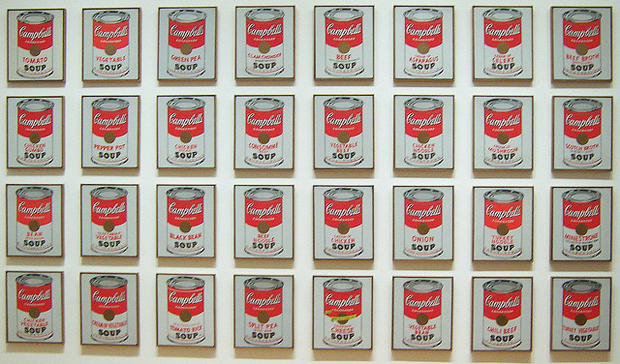
The fascinating story behind Andy Warhol's soup cans
On the show's opening night a rival dealer offered soup cans cheaper in his gallery, Warhol's own gallerist bought back the five he'd sold, including one from Dennis Hopper, then offered to buy entire set from Andy for just $3,000
To celebrate the day of Andy Warhol's birth (he was born this day in 1928) we thought it would be an opportune moment to look back at the story behind one of his most iconic works, 32 Campbell's Soup Cans from 1962. There's a fascinating story about the work in our Phaidon Focus iBook for Mac and iPad and it's also featured in our peerless Andy Warhol Catalogue Raisonné.
Reflecting on his career, Warhol claimed that the Campbell’s Soup Can was his favourite work and that, "I should have just done the Campbell’s Soups and kept on doing them ... because everybody only does one painting anyway." Certainly, it is the signature image of the artist’s career and a key transitional work from his hand-painted to photo-transferred paintings. Created during the year that Pop Art emerged as the major new artistic movement, two of his soup can paintings were included in the landmark Sidney Janis Gallery exhibition, ‘The New Realists’.
{media1}
In the spring of 1962, Warhol had been working on his new renditions of ads and comic strips when he saw Roy Lichtenstein’s comic-strip paintings at Leo Castelli Gallery. Soliciting suggestions for subjects to paint, he asked a friend, who suggested he choose something that everybody recognised like Campbell’s Soup. In a flash of inspiration he bought cans from the store and began to trace projections onto canvas, tightly painting within the outlines to resemble the appearance of the original offset lithograph labels. Instead of the dripping paint in his previous ads and comics, here Warhol sought the precision of mechanical reproduction. At this time he received a return studio visit from Irving Blum of Ferus Gallery, Los Angeles, who was expecting to see comic-strip paintings and was surprised by the new soup cans, immediately offering the artist a show that summer. Expanding his subject, he decided to paint one of each of the thirty-two varieties of Campbell’s soups. Blum exhibited the cans on shelves running the length of his gallery.
The exhibition caused a mild sensation in Los Angeles. The more daring members of the youthful art and film community were intrigued by their novelty. Most people, however, treated them with indifference or outright disdain. A nearby art dealer parodied the show by displaying a stack of soup cans, advertising that you could get them cheaper in his gallery. Blum had sold five of the paintings before he recognised that the group functioned best as a single work of art. He bought back the works already purchased, including one from Dennis Hopper, then offered to buy the set from Warhol in instalments for the modest sum of $3,000.
{media2}
With his Campbell’s Soup Cans installation at Ferus Gallery, the artist realised the possibility of creating works in series, and the visual effect of serial imagery. He continued making variations on his Soup Cans, stencilling multiple cans within a single canvas and so amplifying the effect of products stacked in a grocery store, an idea that he would later develop in the box sculptures. He also realised that the serial repetition of an image drained it of its meaning, an interesting phenomenon most poignantly presented in his Disasters, in which the constant exposure to their graphic displays of violence numbs the senses. And, perhaps the most significant outcome of this series was the artist’s push towards printing to achieve the mechanical appearance that he sought in his paintings.
If that little passage has intrigued you you can order Andy Warhol here in print or here in iBook format for Mac and iPad and check out the other artists in the Focus series here.